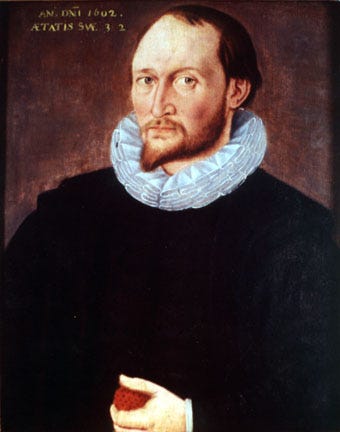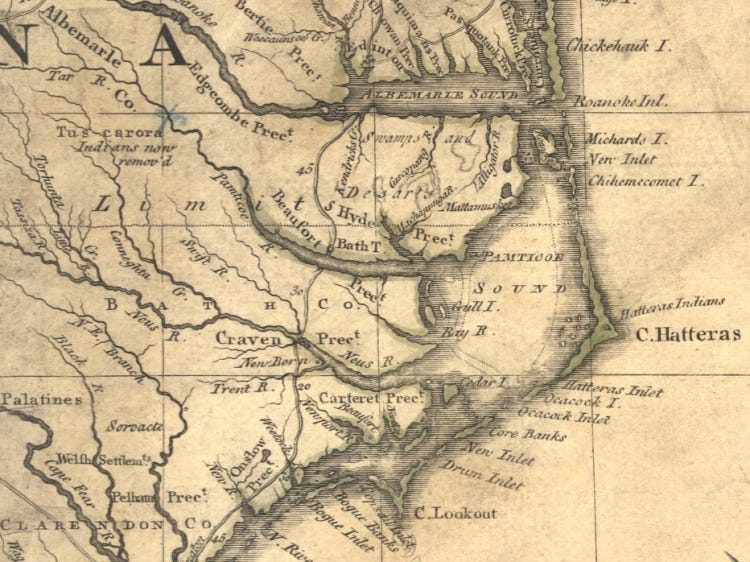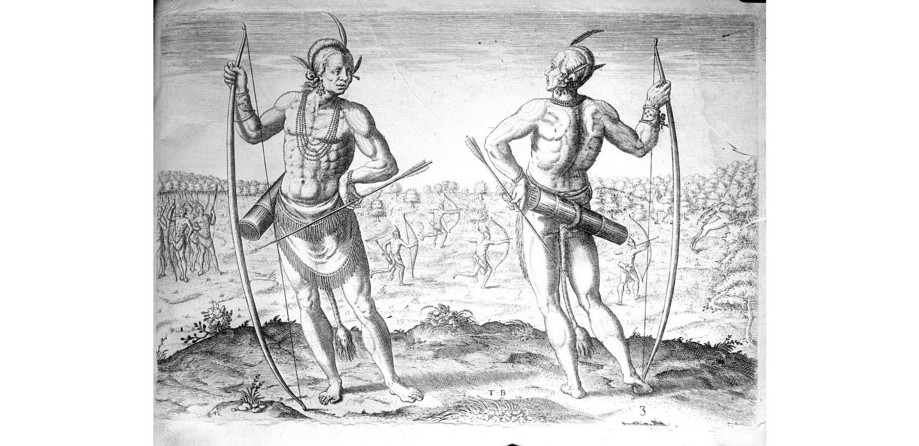One complication faced by historians researching the history of indigenous Eastern North Carolina peoples is the difficulty in untangling the various tribal and place-names found in the written record.
For example, the English settlers who recorded their encounters with the natives often named the tribes for their primary village or vice versa, while the various tribes identified themselves with other names. The language barrier was also a factor.
This changed, however, when Thomas Harriot successfully translated the Algonquian language. When the initial expedition to explore Roanoke in 1584 returned to England, the explorers brought with them the Croatoan chief Manteo and the Roanoke Indian Wanchese. Harriot, a noted English scientist and ethnographer, set out to teach Manteo and Wanchese English, in turn using them to create an alphabet for their native tongue.
When Raleigh organized the return colonization expedition to Roanoke in 1585–1586, Harriot joined the group to conduct research and to help serve as a translator. Subsequent writings on the native populations could thus make more accurate recordings regarding their place-names and tribal identifications in the Algonquian language.
Migrations and upheavals in the geopolitical make-up of the area, however, have made it difficult for modern historians to link some tribal identities and place-names. Native villages often moved when resources were depleted.
The natives’ total dependence on the land meant that some villages barely lasted beyond one generation. As wild game migrated, the soil depleted, or natural disasters such as hurricanes and flooding occurred, the natives would abandon a village and move the settlement to a new location. This has made modern efforts of confirming the locations of noted indigenous villages rather arduous.

Algonquians
The coast of Eastern North Carolina was once home to an abundance of Algonquian tribes. The Iroquoian Tuscarora tribes were more influential within the Upper and Lower Inner Banks and Coastal Plain regions. These various Algonquian-speaking peoples sometimes formed loose affiliations and alliances, which when paired with their overlapping cultural practices, sometimes blurred the lines of individual tribal identification.
For example, the historical mentions of the Weapemeoc Nation can lead to some confusion, as the nation consisted of an association of subdivided tribes named the Pasquotank, Perquimans, and Poteskeet. The Weapemeoc were also often referred to as the Yeopim Indians, presumably from the English’s difficulty in pronouncing the tribe’s Algonquian name.
As English incursions into native territory increased, social disruptions created various cultural shifts within the local tribes further complicating the issue of identity.
The Algonquian nations of Eastern North Carolina possessed a beautiful and well-preserved culture that differed from that of the Europeans in key aspects. Some native tribes in the area were matrilineal, meaning that familial relationships and organization were centered around the mother, as compared to the Western patrilineal culture wherein family lineage was reckoned along the father’s ancestral line.
One of the best examples of this is seen in the case of Manteo’s own mother, who was said to be a leader within Croatoan society before being inadvertently killed by English colonists during a confusing conflict between the Croatoan and Roanoke tribes.
Even in tribes without strict matrilineal practices, women wielded considerable power and influence within the native Carolina populations. In the family unit, individual homes were owned by women, with a man marrying into a woman’s home and joining her family. Clan names were often passed down through the mother, as opposed to the Western tradition of paternal surnames.
The matrilineal customs of the native peoples perplexed the European colonists, as they frequently attempted to deal with only the male members of tribes in matters of trade and diplomacy. Sometimes this confusion over internal tribal power structures led to treaties and land agreements being delayed or misunderstood as the English insisted on dealing only with the men from native settlements even though some tribal leaders were female.
It would be inaccurate, however, to label these native tribes of Eastern North Carolina as matriarchal. Though influence was often passed along maternal lines, men also exercised political influence and tribal control. Hunting and fishing rights were passed from father to son and many tribes recognized a paternal line of authority within their village.
Many villages were founded around a common male ancestor. Shamans were almost always men and had considerable influence over chiefs and elders. If anything, the native populations had relatively balanced gender roles, especially when compared to the European society of the time.
Native women owned the village homes and helped manage the affairs within the village, including cultivating crops and gathering resources. Men hunted and provided protection for the settlement. Both men and women were tasked with helping govern the affairs of their villages.
In matters of politics, the native tribes were characterized by communal leadership rather than a formal system of government. While tribes were led by a chief or central figurehead, the majority of decisions were made by mutual consent of a council of some sort, usually made up of elders and well-respected members of the tribe, though decisions were made in the best interests of the entire village.
While the exact power structure varied from tribe-to-tribe, all Algonquian tribes shared common elements and traits. For example, unlike their Iroquoian counterparts, the Algonquians did not form strong alliances or political bonds with other Algonquian tribes, though they did collectively respond to military threats at times. The Algonquians were more interested in village-based relationships, with many clans who claimed a common ancestry gathering together in a local settlement.
Religion
Algonquian religion was very similar to that of other Native American tribes. Thanks to the work of Thomas Harriot during the Roanoke expeditions, we have extensive details about the spiritual lives of the Carolina Algonquians. The Algonquian tribes encountered by English colonists centered their religious beliefs around a common creation myth.
It surprises many modern readers that, while the natives were not technically monotheistic, they believed in the existence of an eternal chief deity that created lesser spirits (montoac) to manage the cosmos. These spirits of the Algonquian pantheon were often represented by carved anthropomorphic images known as Kewasowok which were placed within temples (machicomuck) and homes for worship, prayer, and offerings.
The Algonquians believed in the immortality of the soul and an afterlife for all people. One’s moral character determined one’s eternal reward. The unrighteous would be tossed into an unquenchable pit of fire (popogusso) that was believed to lie in the west at the setting of the sun. The morally upright, however, would either be reincarnated to live again upon the earth or dwell with their ancestors in the spirit realm.
According to Harriot’s account, the Algonquians practiced traditional burial of their dead, with most burials entailing a simple three feet deep grave. The chiefs and tribal leaders, however, were afforded a special funerary rite.
After death, the bodies of the honored dead were flayed, their bones removed, and the skin reattached to the bones. The remains were then laid out on an elevated scaffold within an ossuary dedicated to the memory of the chiefs. Thomas Harriot provided written descriptions of these funerary practices while John White created detailed watercolors of the ossuaries themselves, drawings that have survived to this day.
Iroquoian
The Iroquoian peoples of North Carolina comprised two primary nations. The Cherokee Nation had the largest native population in all of North Carolina but remained in the far western portion of the state.
The Tuscarora originated in the Great Lakes region, developing alongside their Five Nations kin. Their territory within North Carolina spanned from the southern Piedmont, Upper and Lower Coastal Plain, and the Inner Banks. When encountered by the English colonists, they quickly became known for their industrious use of indigenous hemp which they fashioned into clothing, rope, and medicine.
Like their Algonquian counterparts, the Tuscarora branch of the Iroquoian tribes relied heavily on hunting along with the cultivation of corn (maize), beans, and squash, often referred to as the “Three Sisters” of Native American agriculture.
The Tuscarora also regularly consumed crayfish while children enjoyed plucking young wasps from their nests and eating them as a sort of treat. They also engaged in regular trade with neighboring tribes. Upon the arrival of the English colonists, relations were peaceful, with trade being established between the English and Tuscarora in the late 17th century.
The situation began to sour, however, as the colonists frequently kidnapped Tuscarora men, women, and children to be sold as slaves. Their tribal lands were also taken by force without any form of payment. This eventually led to war between the colonists and Tuscarora in 1711.

The Tuscarora Nation appears to have comprised three primary tribes, with each tribe subdivided into two exogamous clans. The exogamy (intermarriage forbidden between certain groups) practiced by the clans may have stemmed from some form of social class structure not unlike the caste system of historical India. Villages most likely consisted of small settlements of the two different clans.
The Tuscarora village dynamics were similar to that of the neighboring Algonquian tribes. Tuscarora homes were usually made up of short, round pole buildings with a domed roof covered in thick bark that served as shelter from the sun and rain during the summer. They also built the traditional longhouses that the Iroquois were widely known for.
During the winter months, the villagers migrated away from the summer settlements and dwelt in small homes insulated with hemp, with multiple homes closely joined together over fire pits for warmth.
The villages of the Tuscarora Nation coalesced into two loose confederacies known as the Upper Town Confederacy and the Lower Town Confederacy. The upper confederacy covered the region around the Tar, Upper Neuse, and Roanoke Rivers, while the lower confederacy consisted of villages around the Lower Neuse River and Contentnea Creek territories. This division of the Tuscarora Nation would play a crucial role in the outcome of the Tuscarora War.
Religion
The Tuscarora religion centered around two primary deities, the Sky-Holder (Tarachiawagon), sometimes identified with Great Spirit, and the Sky-Woman (Ataensic), or mother goddess. The mythology surrounding Sky-Holder varies from tribe-to-tribe within Iroquoian culture.
In most versions of their cosmology, Sky-Holder is the grandson of Sky-Woman and either the creator of humankind or the benevolent benefactor of the Tuscarora people. A few other Iroquoian cultures hold that Sky-Holder is a title for both Sky-Woman’s husband and grandson and is a recurring hero mantle within their cosmology.
Sky-Woman is generally regarded as the mother goddess who fell to earth through a hole in the sky after she was cast out of the heavens as some form of punishment. The myth varies, with some saying that Sky-Woman was expelled for violating a cultural taboo or because of the jealousy of her husband. She becomes the mother or grandmother, depending on the version of the cosmology, to Sky-Holder and Flint — sometimes referred to as Good Spirit and Bad Spirit, respectively.
Direct communication with the spirit world was considered impossible, though the regular burning of tobacco was believed to carry one’s prayers to the lesser Spirits of Good. Other important spirits and deities in Iroquoian religion included Onatah, the Spirit of the Corn — an important fertility goddess and one of the Three Sisters along with Beans and Squash, The Thunders (Onditachiae) — powerful spirits that inhabited the sky and caused thunderstorms, and the feared Stone Coat — a race of giant rock monsters, possibly former humans who have been cursed, that hunted and ate humans. The legend of Stone Coat shares some similarities to the Chippewa Windigo.
The interpretation of dreams played a central role in Iroquoian spirituality. They believed dreams to be the desires of the soul. Fulfilling these desires was regarded as an important spiritual journey to be accomplished by the dreamer, often with the help of a religious leader. The Iroquoian religious system, however, lacked a dedicated priesthood or shamanic element. Various male and female villagers, often called Keepers of the Faith, dedicated part of their time to conducting religious ceremonies and enforcing social norms.
The Iroquoian funerary rites, as practiced by the Tuscarora, were very similar to the Algonquian tradition. Sometimes the deceased were placed on scaffolds in trees. Oftentimes the dead were buried with important personal artifacts in traditional graves outside the village.
The Tuscarora believed in the immortal soul. When one died, one’s soul set out on a journey where various trials and ordeals were encountered, finally ending with the soul departing for the Sky World. The journey was believed to last a year, which was marked by a yearlong period of mourning and concluded with a feast in celebration of the departed one’s successful entry into the Sky World.
Both the Iroquoian and Algonquian tribes of Eastern North Carolina held time-honored customs and beliefs that predated the arrival of Europeans by centuries, if not millennia. As the English colonists began to expand into Native territory and establish trade relationships with the various tribes, the native populations began to suffer irreparable harm.
Disease, warfare, slavery, land theft, and the disruptive nature of the colonists’ technological advancements quickly reduced the Carolina Natives’ populations within a century of initial contact with the Europeans. Their cultures were also forever changed, with many tribes assimilating into the newly encountered European way of life and disappearing from the pages of history.
References
Harriot, Thomas. A Brief and True Report of the New Found Land of Virginia. Whitefish, MT: Kessinger Pub., 2005. Originally published in 1585
Johnson, Elias. Legends, Traditions, and Laws of the Iroquois, or Six Nations,
and History of the Tuscarora Indians. Tredition Classics, 2013.
Vaughan, Alden T. “Sir Walter Ralegh’s Indian Interpreters, 1584–1618.” The William and Mary Quarterly 59, no. 2 (2002): 341–76. doi:10.2307/3491741.


Be First to Comment